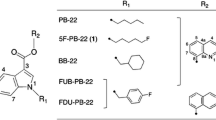Abstract
Quinolin-8-yl 1-pentyl-(1H-indole)-3-carboxylate (QUPIC) is a newly introduced synthetic cannabinoid in the drug market. This drug was found to undergo thermal decomposition during gas chromatography–mass spectrometry (GC–MS), probably because of the presence of an ester bond in its structure. Most notably, when QUPIC dissolved in methanol or ethanol was analyzed by GC–MS, most of the QUPIC decomposed to give thermal degradation products. We identified the products as methyl 1-pentyl-(1H-indole)-3-carboxylate, ethyl 1-pentyl-(1H-indole)-3-carboxylate, and methyl indole-3-carboxylate by comparison of their mass spectra with those of reference standards synthesized in our laboratory. Nonalcoholic solvents such as acetone and chloroform gave a major peak and a minor peak for unchanged QUPIC and the degradation product 8-quinolinol, respectively. Furthermore, we studied the effects of various parameters, such as injection methods (splitless or split, and split ratio), injector temperatures, and injector liners on the thermal degradation of QUPIC. Split injection was effective in avoiding degradation. When performing splitless injection, an injector temperature of 250 °C and a surface deactivated injector liner without glass wool minimized the degradation and enhanced the sensitivity. These results indicate that special attention is required for GC–MS analysis of QUPIC, and the information presented in this study will be very useful for forensic toxicologists using GC–MS.



Similar content being viewed by others
References
Auwärter V, Dresen S, Weinmann W, Müller M, Pütz M, Ferreirós N (2009) ‘Spice’ and other herbal blends: harmless incense or cannabinoid designer drugs? J Mass Spectrom 44:832–837
Uchiyama N, Kikura-Hanajiri R, Kawahara N, Haishima Y, Goda Y (2009) Identification of a cannabinoid analog as a new type of designer drug in a herbal product. Chem Pharm Bull 57:439–441
EMCDDA (2013) EMCDDA-Europol 2012 annual report on the implementation of council decision 2005/387/JHA. EMCDDA/Europol, Lisbon
Zuba D, Byrska B (2013) Analysis of the prevalence and coexistence of synthetic cannabinoids in “herbal high” products in Poland. Forensic Toxicol 31:21–30
Kikura-Hanajiri R, Uchiyama N, Kawamura M, Goda Y (2013) Changes in the prevalence of synthetic cannabinoids and cathinone derivatives in Japan until early 2012. Forensic Toxicol 31:44–53
Uchiyama N, Matsuda S, Kawamura M, Kikura-Hanajiri R, Goda Y (2013) Two new-type cannabimimetic quinolinyl carboxylates, QUPIC and QUCHIC, two new cannabimimetic carboxamide derivatives, ADB-FUBINACA and ADBICA, and five synthetic cannabinoids detected with a thiophene derivative α-PVT and an opioid receptor agonist AH-7921 identified in illegal products. Forensic Toxicol 31:223–240
Shevyrin V, Melkozerov V, Nevero A, Eltsov O, Shafran Y (2013) Analytical characterization of some synthetic cannabinoids, derivatives of indole-3-carboxylic acid. Forensic Sci Int 232:1–10
Kavanagh P, Grigoryev A, Savchuk S, Mikhura I, Formanovsky A (2013) UR-144 in products sold via the Internet: identification of related compounds and characterization of pyrolysis products. Drug Test Anal 5:683–692
Foreman WT, Gates PM (1997) Matrix-enhanced degradation of p,p′-DDT during gas chromatographic analysis: a consideration. Environ Sci Technol 31:905–910
Grob K, Wagner C (1993) Procedure for testing inertness of inserts and insert packing materials for GC injectors. J High Resolut Chromatogr 16:464–468
Tsujikawa K, Kuwayama K, Kanamori T, Iwata YT, Inoue H (2013) Thermal degradation of α-pyrrolidinopentiophenone during injection in gas chromatography/mass spectrometry. Forensic Sci Int 231:296–299
Adam JM, Cairns J, Caulfield W, Cowley P, Cumming I, Easson M, Edwards D, Ferguson M, Goodwin R, Jeremiah F, Kiyoi T, Mistry A, Moir E, Morphy R, Tierney J, York M, Baker J, Cottney JE, Houghton AK, Westwood PJ, Walker G (2010) Design, synthesis, and structure-activity relationships of indole-3-carboxamides as novel water soluble cannabinoid CB1 receptor agonists. Med Chem Commun 1:54–60
Moosmann B, Kneisel S, Wohlfarth A, Brecht V, Auwärter V (2013) A fast and inexpensive procedure for the isolation of synthetic cannabinoids from ‘Spice’ products using a flash chromatography system. Anal Bioanal Chem 405:3929–3935
Nishida T, Tokuda Y, Tsuchiya M (1995) Synthesis of 1-substituted indoles by the vapour phase reaction of N-substituted anilines with glycols and epoxides over a solid catalyst and a vapour phase dealkylation of 1-alkylindole. J Chem Soc Perkin Trans 2:823–830
Conflict of interest
There are no financial or other relations that could lead to a conflict of interest.
Author information
Authors and Affiliations
Corresponding author
Rights and permissions
About this article
Cite this article
Tsujikawa, K., Yamamuro, T., Kuwayama, K. et al. Thermal degradation of a new synthetic cannabinoid QUPIC during analysis by gas chromatography–mass spectrometry. Forensic Toxicol 32, 201–207 (2014). https://doi.org/10.1007/s11419-013-0221-6
Received:
Accepted:
Published:
Issue Date:
DOI: https://doi.org/10.1007/s11419-013-0221-6




